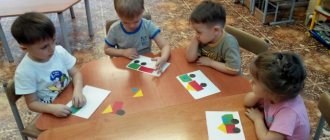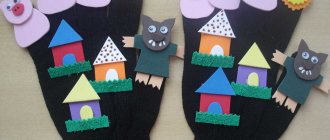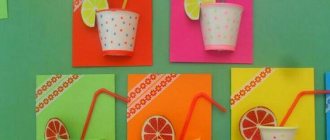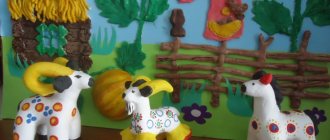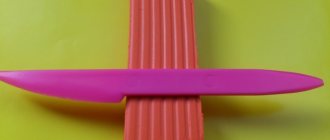Pencils for dolls
Goal: To instill in children empathy for game characters and arouse a desire to help them. Practice rolling lumps of plasticine between your palms with straight movements; learn to give them the shape of a pencil. Strengthen knowledge of colors.
Material: Empty boxes of colored pencils, plasticine.
Progress of the lesson
Creating gaming motivation. Before class, empty boxes of colored pencils are placed next to the dolls. On behalf of the dolls, the teacher conveys their request: they would really like to have pencils. There are empty boxes, but no pencils.
The teacher invites the children to help the dolls. Children take empty boxes and take a place at the work tables.
Children are already familiar with the technique of rolling plasticine between their palms with straight movements. Therefore, you can attract those who have mastered it to the show. The teacher only shows the children how one of the ends of the sculpted column is slightly squeezed with the fingers to give it the shape of the sharpened side of a pencil.
To consolidate the names of already known colors, the teacher, on behalf of the toys, asks someone what color pencil he made. In case of difficulty, the teacher names the color of the pencil.
Games with plasticine for the development of fine motor skills in children with disabilities
Games with plasticine for the development of fine motor skills in students with disabilities (intellectual disabilities)
Author: Olga Evgenievna Muravyova, primary school teacher, OKOU “Boarding School No. 5”, Kursk. Description: The development contains a description of work experience in developing creative abilities in students with disabilities (intellectual disabilities). This article may be useful for educators, primary school teachers, and parents of students. The goal of developing creative abilities in students with disabilities is aimed at ensuring their spiritual and moral development and education, socialization, family and professional guidance. Objectives: 1. Contribute to the correction of defects in the mental and physical development of students with disabilities.
2. Develop sculpting skills and use different techniques. Progress of the lesson
Children with disabilities
are children who have serious deviations in mental development, and as a result, deviations in development and behavior.
These children need the attentive, kind attitude of adults, and first of all, a teacher. With such children, systematic, consistent work and great patience are needed. Plasticine provides unique opportunities to play interesting and useful games. Modeling
is an interesting and useful activity that all children love; it is an excellent way to develop fine motor skills, muscles and coordination of both hands, develops spatial thinking, imagination, and finger coordination. The child prepares his hand to master such a complex skill as writing. This is all facilitated by good muscle load of the fingers. One of the undoubted advantages of plasticineography classes with children of primary school age is the integration of subject areas of knowledge. Playing with plasticine allows you to integrate different educational areas. The topics of the classes are closely intertwined with the lives of children, with the activities that they carry out in other classes (to become familiar with the surrounding world and nature, develop speech, etc.).
In an interesting playful way, children with disabilities enrich their vocabulary. In the process of playing out the plot and performing practical actions with plasticine, there is a continuous conversation with the children. Such a playful organization of children’s activities stimulates their speech activity, causes speech imitation, the formation and activation of a vocabulary, and the child’s understanding of the speech of others. They get acquainted with works of art, poems, nursery rhymes, and finger games. Often, in drawing classes, children have the opportunity to realize their accumulated experience, knowledge and skills. For example, children must complete the missing elements of the drawing (complete the portrait, add antennae for the mouse, eyes and tail for the bunny, etc.).
Children of primary school age really enjoy working with plasticine. During manual labor and drawing lessons, I offer children the following tasks: Roll plasticine balls and decorate the dishes.
Complete the image.
Apply plasticine to the drawing using the smearing method.
Decorate the butterfly's wings with a multi-colored pattern.
Didactic game “Plasticine patches” Purpose: Development of attention and logical thinking in children with disabilities. Objectives: Teach children to select appropriate “patches” by color and size. Develop logical thinking, attention, fine motor skills. Progress of the game: Option No. 1:
(Individual work) The child is given cards with missing parts of the picture, and plasticine - the so-called “Patches”.
The child must choose the color and make the desired patch. Option No. 2:
(group game) Several children are given 1 card with missing parts. Children must pick up their “patches” faster. As practice shows, this is a very exciting game!
Drawing with plasticine is of particular interest to children. We most often return to this technique when performing such works as “Mushrooms”, “Flowers”, “Birds”, “Vegetables and Fruits”.
In my handicraft classes, I use modeling to show non-standard techniques for working with plasticine.
Applique using various types of plasticine, making three-dimensional figures from ball plasticine is a simple but unusual form of creativity. These activities improve attention and fine motor skills; develop fantasy and imagination; cultivate perseverance. Ball plasticine consists of balls and glue threads, it does not stick to fingers, is pleasant to the touch, has very bright colors and evokes a lot of positive emotions in children. When making three-dimensional figures, I introduce children to the properties of this plasticine: it can be coarse-grained and fine-grained, hardening and not hardening. Fine-grained plasticine does not hold its shape well, so I teach children to first make a base out of paper (balls, ovals), and then cover it with plasticine. In the second lesson, I give the children the opportunity to make animal figures according to their ideas or from sample pictures. During classes, some children are curious, do the work independently, and are interested in evaluation of their work. Others lack initiative and do the easiest work quickly. But I make sure that the child does not make shapeless mistakes, I force him to redo it, compare it with models. During the lesson I monitor the children’s tone. If I see that they are tired, I take a break. At the end of the lesson, together with the children, we clean the workplaces, make sure their clothes are clean, and wash their hands. To demonstrate creative abilities, it is not enough to give a child a piece of plasticine; a positive example is needed. And here I want to talk about the leading role of the teacher in this work, who must be able to draw, sculpt, and give the opportunity to observe the process of making products. These observations arouse children's interest in this type of activity and the desire to imitate an adult. The lesson consists of 4–5 parts:
1. Emotional mood 2. Reading a poem or looking at illustrations on the topic of the lesson, showing a sample. 3. Finger gymnastics. 4. Explanation of the task. 5. Direct work. The specifics of the classes are determined by their characteristics: the speed of onset of fatigue, dullness of the reaction to the instructions of an adult. Therefore, for correctional purposes, I use doing the work in parts, alternating explanation with doing the work. Switching activities increases efficiency and normalizes the pace of work. I definitely include finger exercises, the use of which is most conducive to the development of productive activity and children really like it. Finger games are very exciting. We play with our fingers - we develop speech and creative activity. Children are happy to repeat movements and develop fine motor skills. This is how you develop the ability to control your movements and coordinate your attention. A great incentive for students is the school exhibition of creative works in decorative and applied arts, where the best works are displayed.
We recommend watching:
DIY snow woman. Master class with step-by-step photos Do-it-yourself educational game made from felt for kindergarten Summary of a lesson on speech development in an early age group on the topic “Kolobok” Calendar-thematic planning for the development of fine motor skills in preschoolers
Similar articles:
Exercises to prepare the hand for writing for older preschoolers
Do-it-yourself mathematical didactic game for the younger group
Children's development largely occurs through play. Children 2-3 years old, who are just joining the ranks of preschoolers, begin to spend a lot of time in a group of peers, gaining new knowledge. Do-it-yourself didactic games are especially valuable in preschool educational institutions. This is the warmth and care of a master who puts his soul into each child, as well as the opportunity to give children sensory development and first skills in mathematics and logic. We present to your attention a master class on creating a bright didactic game with a mathematical bias for the younger group of preschool educational institutions, which older preschoolers will also enjoy playing. The process is accompanied by pictures, so it will be easier for you to create.
Do-it-yourself didactic games - mathematics can be interesting
To make a didactic game with your own hands, you first need to prepare and, which is very important, calculate the material.
Let's call it "Harvest" - the guys will be able to put three types of fruit on three different trees, and then collect them in plates, leaving the leaves.
When the kids grow up, they will be able to play this didactic game with a different interest: count which fruits they have collected more or less, and distribute equally to all children.
For preschoolers in kindergarten, it is important not only to play, but also to learn new knowledge. In the didactic game “Let's Harvest,” preschoolers come to the idea of what kind of fruits grow on trees, what exactly these are fruits. They can tell what fruits taste like in each individual case, share their opinions about them, and this is the development of speech. Let's get started!
Creative materials
Anything you have can be useful. In total, you need to make three trees, several fruits of three types (for us these will be plums, pears and apples), three plates for them, and also, if desired, leaves. In order for children to develop their sensory skills as best as possible, it is worth making parts from different materials. It could be:
- Felt. Do-it-yourself didactic games made from this material are considered one of the best, since it is wear-resistant, has many beautiful colors and is easy to create.
- Rubber (or rubberized colored paper).
- Cardboard (thin and thick).
- Self-adhesive paper.
- A box or casket in which you can put parts of a didactic game.
- Of course, for the DIY process you will need scissors, a needle, colored threads (preferably floss), and a ruler. We also used green gouache to paint the back of the trees.
Source: https://mojdetskijsad.ru/pedagogam-na-zametku/matematicheskaya-didakticheskaya-igra-dlya-mladshej-gruppy-svoimi-rukami.html
Summary of OOD on modeling in the senior group “Sculpting fairy-tale characters”
Cherepanova Natalya
Summary of OOD on modeling in the senior group “Sculpting fairy-tale heroes”
Goal: consolidation of knowledge of Russian folk tales .
Mastering the techniques of sculpting three-dimensional figures from dough.
Improving teamwork skills.
Continue to develop the ability to convey the characteristic movements of humans and animals, convey the shape of the main part and other parts, their proportions, posture, characteristic features of the depicted objects;
Development of imaginative thinking, imagination, creative abilities.
Cultivate perseverance and hard work.
Material for the lesson:
modeling boards , stacks, wet wipes, a collection of Russian folk tales .
Integration of educational areas:
"Reading fiction"
,
Educational games
If your child is a fan of all kinds of educational games, he will certainly enjoy the activities offered.
Many children will find voluminous plasticine manuals even more interesting and understandable than printed board games. Gather toy animals at the table and make suitable food for them. Several of these games, and the child will easily remember that the sheep loves grass, the cockerel loves grains, and the cat loves fish.
Another activity can be devoted to sculpting a man. Make a sausage body, attach a ball head to it and stop. Let the child advise what else to sculpt, whether one arm is enough, where to attach the leg. If the child cannot give a hint, the adult must say it himself - what he is doing and why. While studying the structure of the body, do not forget about the parts of the face. Sculpt the eyes, nose, mouth, ears. Let your child place them on his head or show you how to do it.
Make flat and three-dimensional geometric shapes. And then show how, with the help of a few additional details, the ball becomes an apple, and a few triangles become the petals of a flower. An older child will be able to lay out pictures from flat figures himself.
Another magical game is to sculpt not just static figures, but their transformations. To involve your baby in the gameplay, ask him to “pluck leaves” by pinching off pieces of plasticine and feed the caterpillar you have made. The caterpillar “eats” every leaf the child holds out, becoming longer and thicker. And then demonstrate how she hides in a cocoon and then comes out of it as a butterfly (you need to sculpt the butterfly as quickly as possible). No less fascinating will be the transformations of a flower growing from a seed or the metamorphosis of a frog.
If your classes last long enough and the child does not tend to destroy all the crafts, play generalization. Arrange all the molded figures into categories - transport, food, animals. If your child likes it, next time invite him to sort fruits and vegetables into two groups, to separate edible from inedible or domestic animals from wild ones.
A child who has been watching modeling for a long time can play riddles. Tell your child that you are about to make an animal (food, transport, flower), and let him guess who exactly you are creating before the figurine is finished.
DIY educational games
It would seem that now you can buy almost any toys.
Why reinvent the wheel and engage in amateur activities? But games made by mother’s hands always enjoy special love from the baby, and even if they turn out not quite perfect, they are certainly original and with a considerable share of mother’s warmth and love. Plus, in the current uncertain economic climate, homemade toys can help you save some money to buy something more worthwhile, like children's books.
I admit that I do not belong to the category of handicraft mothers, rather the opposite. But with the birth of my daughter, the situation suddenly changed: I wanted to create something (or at least try to do it), tinker, invent. As it turned out, this requires a minimum of time and material costs, and the child’s enthusiastic reaction is the most pleasant reward.
Tactile bags
To make them you will need some colorful scraps and various fillings: cereals, beans, pebbles, rustling polyethylene, cotton wool, salt, small coins, etc. It is advisable to choose fabric of bright colors and different textures. You can also sew two-color bags.
Just cut out squares from the fabric, for example, 8x8 cm + 0.5 cm for allowances on each side. Sew the bags, leaving a small hole, turn them inside out, fill them with stuffing and sew up the hole. The baby will be interested in exploring rustling, ringing, crispy bright toys.
Plasticine theater
A child’s acquaintance with plasticine can take place at 8 months, or maybe after two years. But, in any case, it will most likely begin not with independent modeling, but with observation of your actions. The kid will order the production of new and new figures, will happily crush your most successful crafts, and will try to eat a piece of plasticine on occasion or throw it away.
And the parents will have to sculpt. And not just sculpt, but with enthusiasm, joy and surprise, remove a kitten or a mouse (or a snake, if sculpting is not your thing) from the house block. Luckily for many parents, no special artistic talent is required. The created figures should be so simple that in the near future even a child will be able to repeat them. But your acting skills will have to be developed. It’s good if the sculpted animal, to the delight of the baby, sings him a song, talks about his life, or asks him questions.
When the child gets comfortable with such an unusual toy, you can act out the plot of a famous fairy tale, sculpting all its characters. Moreover, it is better to sculpt as the tale progresses. For example, together with your baby you call: “Cat! Go carry the turnip” - and at the same time sculpt a figurine of a cat.
Over time, the child can become a full-fledged actor in your theater and, perhaps, he himself will want to invent and create doll figures.


